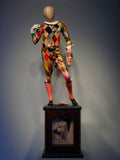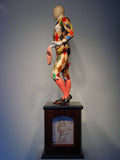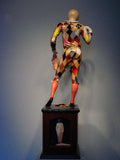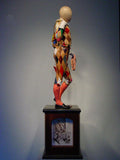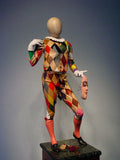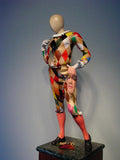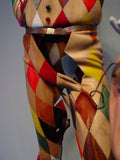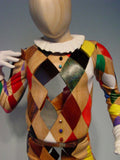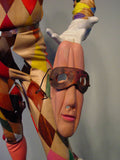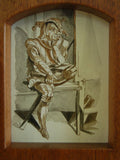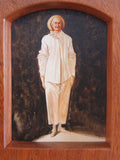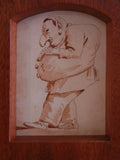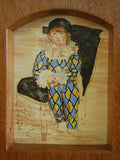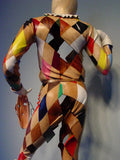Harlequin, Punchinello, Pierrot and many other theatrical characters have been part of European culture for hundreds, even thousands of years. Harlequin certainly can be traced back to pre-Roman times.
They were the stars of yesteryear - evolving over the centuries. Originating in Naples, Punchinello became Mr Punch in Victorian England and Pierrot became a circus clown.
Harlequin, the vulgar buffoon and performer, became the elegant figure of the English ‘Harlequinade’.
Artists and sculptors portrayed these characters over the centuries because they were important figures in society. Picasso painted, I believe, 27 pictures featuring Harlequin.
This carving of the Hollow Man is one of the most complex I have undertaken. Each part of the figure is carved in solid limewood, then largely cut away and hollowed out. It is then rebuilt in thin, shaped diamonds of different timbers with certain diamonds missing to reveal the hollow interior.
Without his costume Harlequin does not exist - there is no one inside - just like the ‘Hollow Man’ whose costume is falling away. Harlequin was an illusion - it was the costume and not the person who created the character.
Now these characters are consigned to the dustbin of history, their services no longer required, their humour replaced by TV celebrities and their satire by the Simpsons. Without the recognition of their ‘uniform’, they cease to have any relevance in modern society.
The performer today is a celebrity. ‘Image’ is a modern concept. It is universally accepted that what a person ‘appears to be’ is more important than what they really are. We live in a society where the truth behind the image is (conveniently) ignored.
The paintings I have reproduced on the base show some studies of clowns by leading artists.
The portrait of Punchinello by Tiepolo is one of the hundreds that he painted. Indeed there are large murals of Punchinello decorating a palazzo in Venice by Tiepolo and his brother.
The study of the Jester by Fuseli, famous for his wonderful illustrations of Shakespeare plays, is from a painting of a jester being painted by another artist.
The figure of Pierrot is from a very famous picture by Watteau depicting a group of Italian comedians. The lavish scale of the original picture shows the esteem in which these people were held in.
The Picasso portrait of his son Paul dressed as Harlequin, a subject repeatedly painted by him in the years leading up to the Second World War.
Limewood and mixed media
30 inches / 76 cm high
including the base
INCLUDES INTERNATIONAL SHIPPING

